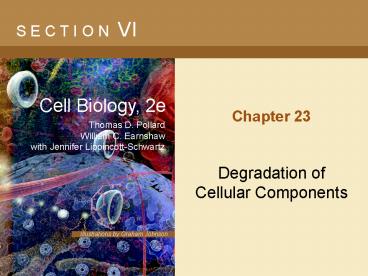Introduction to Physiology: The Cell and General Physiology - PowerPoint PPT Presentation
1 / 16
Title:
Introduction to Physiology: The Cell and General Physiology
Description:
Excessive autophagy can result in cell death, but scientists are currently debating whether autophagy represents a distinct pathway of programmed cell death. ... – PowerPoint PPT presentation
Number of Views:1091
Avg rating:3.0/5.0
Title: Introduction to Physiology: The Cell and General Physiology
1
(No Transcript)
2
Question 1. Lysosomal degradation of plasma
membrane proteins internalized by endocytosis is
important for
A. down-regulation of signal transduction
pathways.B. remodeling of cells and
tissues. C. creating free space to allow
insertion of new membrane proteins.D. regulati
on of the cell cycle.E. presentation of
antigens in the immune response.
3
Answer
A. down-regulation of signal transduction
pathways.
4
Feedback
When EGF binds to its receptor, the half life of
the receptor is decreased some 10-fold, thereby
down-regulating the biological response.
5
Question 2. When cells are starved for amino
acids they often recycle cellular components by
digesting regions of their own cytoplasm. This
process is known as
A. apoptosisB. crinophagy C. necrosis D. autop
hagy E. envelopment
6
Answer
D. autophagy
7
Feedback
Excessive autophagy can result in cell death, but
scientists are currently debating whether
autophagy represents a distinct pathway of
programmed cell death.
8
Question 3. Intercellular proteins destined for
degradation are targeted to the
A. lysosome. B. endosome. C. multivesicular
body. D. proteasome.E. ribosome.
9
Answer
D. proteasome.
10
Feedback
Proteasomes are closed cylindrical chambers lined
on the inside with several proteases that
efficiently destroy any proteins that enter the
chamber.
11
Question 4. Which of the following is not true of
ubiquitin-mediated proteolysis?
A. Ubiquitin is activated by conjugation to an E1
Ubiquitin-activating enzyme. B. The E1 then
transfers its ubiquitin to an E2
Ubiquitin- conjugating enzyme. C. The E2
transfers the ubiquitin to an E3
Ubiquitin- protein ligase. D. The E3 transfers
ubiquitin to a lysine residue on a target
protein. E. The proteasome recognizes the
ubiquitin-protein conjugate, pulls it into its
chamber, and degrades the complex to short
peptides.
12
Answer
E. The proteasome recognizes the
ubiquitin-protein conjugate, pulls it into its
chamber, and degrades the complex to short
peptides.
13
Feedback
When ubiquitin-protein conjugates are targeted to
the proteasome, the ubiquitin is removed and
recycled. Only the target protein is degraded.
14
Question 5. Proteolytic processing of a
transcription factor regulates levels of which of
the following?
A. LDL B. CholesterolC. Lysobisphosphatidic
acidD. PI3-PE. HMGCoA
15
Answer
B. Cholesterol
16
Feedback
When levels of cholesterol are high, SREBP is
retained in the ER, where it remains intact. If
cholesterol levels drop, SREBP escapes from the
ER to the Golgi apparatus. There it is cleaved,
releasing a transcription factor domain, which
enters the nucleus and stimulates transcription
of genes required for cholesterol synthesis and
uptake.































